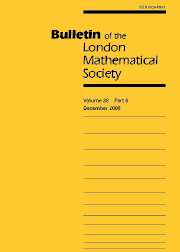No CrossRef data available.
Article contents
MAXIMAL NORM OF C(S)
Published online by Cambridge University Press: 01 May 1997
Abstract
Let S be a locally compact Hausdorff space, and let C0(S) be the Banach space of complex-valued continuous functions on S vanishing at infinity. It is known [1, p. 93] that every isometry U on C0(S) has the form
(Uf)(s)=θ(s)f(γ(s)) (s∈S), ([midast ])
where γ is an automorphism of S, and θ is a continuous function on S satisfying [mid ]θ(s)[mid ]=1 for all s∈S. Recall that a norm on a Banach space X is maximal if there is no equivalent norm for which the group of isometries is strictly larger. It is easy to see that the norm of C0(S) is not maximal if S contains a finite number of isolated points (S has at least two isolated points) [3, Remarks on Theorem 8.2]. In [3, 5, 6], Kalton and Wood proved the following theorem.
- Type
- Research Article
- Information
- Copyright
- © The London Mathematical Society 1997


